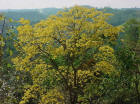
return to: http://www.deckspecialists.com/
 Deck Specialists, Inc. Report on Ipe (ee-pay) Botanical Information Trade or Common
Name: Ipe,
lapacho, cortez, Pau Lope®, ironwood, The Tree: The Wood: Ipe heartwood is light to dark olive brown, often with attractive lighter or darker striping and a beautiful grain similar to American walnut. It has a fine texture, medium luster, and a somewhat oily appearance. Ipe is very hard (two to three times as hard as oak), very strong and very heavy. It weighs approximately 70 pounds per cubic foot and sinks in water. Ipe is rated as extremely durable. Uses: Ipe is prized for quality furniture and decorative veneers, and because of its strength and durability, is used in boardwalks, decking, porch floors, tool handles, turnery, industrial flooring, and textile mill items to name a few.. This fantastic and durable South American Hardwood is rated by the US Forest Products Lab for 25 years plus. It is resistant to fire naturally, has a rating of Class A by the NFPA or class 1 by the UBC, and resists insects, moisture, and movement. This wood is perfect for exterior residential and commercial applications such as boat docks, decking, boardwalks, outdoor furniture, etc. It can be sealed to maintain its natural color and beauty, or weathered to a beautiful splinter free silver gray patina. It is available in various standard dimensions and can be cut with high quality carbide tipped blades. It does however require extensive pre-drilling and screwing with ceramic-coated steel screws. Hidden fastening systems are not recommended. Standard decking size is 4/4 material not 5/4 or 8/4. On 24" centers the 4/4 material will provide a 100 lb. load rating far better than any cedar, redwood, or CCA pressure treated material. It has a hardness rating of 3640 Janka, almost 3 times better than that of Red Oak. Ipe is also resistant to surface checking and naturally resistant to molds, insects and decay. When compared to other woods such as redwood, cedar, or copper chromium arsenate pressure treated materials, Ipe lasts much longer (3-5 times the life span), a stronger resistance to fire, insects, weather and movement. By comparison, the value of Ipe is very clearly the best timber product for outdoor usage bar none. Cutting and Drilling: Premium carbide tipped saw blades and high quality carbide drills are recommended for smooth cuts due to the hardness of Ipe. Pre drill a pilot hole and countersink when using screws as fasteners. End Sealing: Ends should be sealed immediately after cutting using a clear aqueous wax end sealer to reduce end checking. Allowable Ipe Spans
This South American species is a very stable and durable timber. It dries extremely well with little checking, twisting, or bow. It is widely known for its strength and natural resistance to decay and it can be used in ground contact without preservatives or additional treatments. Testing by the US Navy in a Panama Canal study from 1962 showed Ipe to be one of the top performers in resistance to decay, termites, and borers. Of those hardwoods tested it was one of the very few that is commercially available. Extensively used in commercial exterior construction such as boardwalks, piers, and benches, it has recently become the top choice for residential decks due to its low maintenance, attractive color, and very smooth surface and the fact that is lasts over 25 years! It is a heavy timber, approximately 70 lbs. per cubic foot when dry, sinks in water, and has a fire rating of Class A, (the same as concrete or steel). Uses include: residential and commercial decking, boardwalks, piers, fencing, park benches, any outdoor structures receiving extreme duty. One of the more famous commercial applications for Ipe has been the Atlantic City Boardwalk: After 24 years of use, the planks used show almost no wear! Ironwoods in general remain smooth and splinter free due to their being one of the earth's most dense woods. They will not absorb water like softer wood do, twist, splinter, or bow like some woods do. This means that if you use Ipe for your deck, you will be able to walk on it barefoot for a lifetime. Comparison Chart
Environmental Information Diamond Hardwoods, Inc. is committed to the preservation and responsible utilization of the earth's resources. Our mills implement sound environmental practices by conforming to National Forest Law and International Tropical Timber Organization guidelines. We source exclusively from managed forests and support the following meaningful environmental organizations: FSC- (Forest stewardship Council) All forest products have been independently certified as coming from forests that meet internationally recognized FSC principles and criteria of the Forest Stewardship. The forest inspections are carried out by a number of FSC accredited certification bodies, which are evaluated and monitored to ensure their competence and credibility. (Tropical Forest Foundation) TFF's sustainable forest management brings together conservation and industry leaders in an effort to improve natural forest management by promoting the use of low impact logging (LIL) practices. Their primary focus is to demonstrate and teach sustainable forest management through Low-impact Logging.
Ipe decking weathered to a beautiful silver patina after only a couple seasons without any oilings |
http://www.deckspecialists.com/
 Ipe is a large canopy tree, growing to a height of 120 feet in the natural rain
forest, with trunk diameter up to 3 feet and a clear bole of 60 feet. Some
specimens grow to 150 feet with a 6 foot diameter trunk
Ipe is a large canopy tree, growing to a height of 120 feet in the natural rain
forest, with trunk diameter up to 3 feet and a clear bole of 60 feet. Some
specimens grow to 150 feet with a 6 foot diameter trunk